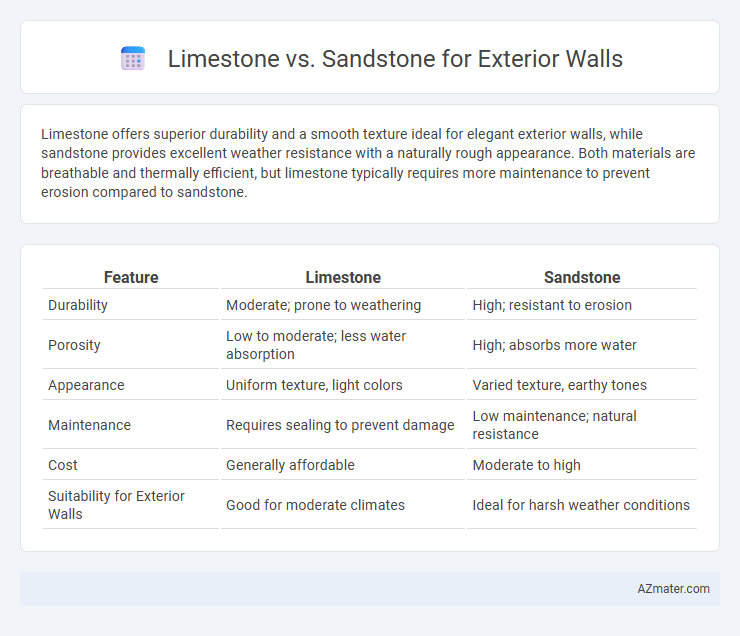Limestone offers superior durability and a smooth texture ideal for elegant exterior walls, while sandstone provides excellent weather resistance with a naturally rough appearance. Both materials are breathable and thermally efficient, but limestone typically requires more maintenance to prevent erosion compared to sandstone.
Table of Comparison
| Feature | Limestone | Sandstone |
|---|---|---|
| Durability | Moderate; prone to weathering | High; resistant to erosion |
| Porosity | Low to moderate; less water absorption | High; absorbs more water |
| Appearance | Uniform texture, light colors | Varied texture, earthy tones |
| Maintenance | Requires sealing to prevent damage | Low maintenance; natural resistance |
| Cost | Generally affordable | Moderate to high |
| Suitability for Exterior Walls | Good for moderate climates | Ideal for harsh weather conditions |
Introduction to Limestone and Sandstone
Limestone is a sedimentary rock primarily composed of calcium carbonate, known for its durability and natural resistance to weathering, making it a popular choice for exterior walls. Sandstone consists of compacted sand-sized mineral particles, typically quartz, offering a wide range of colors and textures that enhance architectural aesthetics. Both materials provide strong structural integrity but differ in porosity and maintenance requirements for exterior applications.
Geological Composition and Formation
Limestone primarily consists of calcium carbonate derived from marine organisms, forming through the accumulation of skeletal fragments in warm, shallow seas. Sandstone is composed mainly of quartz and feldspar grains, cemented together over time through sediment deposition in environments like rivers, deserts, or beaches. The geological formation of limestone results in a denser, less porous material compared to the often more porous and grainy texture of sandstone, influencing durability and weather resistance for exterior walls.
Visual Appeal and Aesthetic Differences
Limestone exhibits a smooth, uniform texture with subtle color variations ranging from creamy white to pale gray, providing a timeless, elegant aesthetic ideal for classic architecture. Sandstone offers a more granular surface with rich, earthy tones such as reds, browns, and yellows, creating a warm, rustic charm that enhances natural and contemporary designs. The choice between limestone and sandstone significantly influences the exterior wall's visual appeal by balancing refined sophistication against textured warmth.
Durability and Weather Resistance
Limestone offers moderate durability with a porous structure that can absorb moisture, potentially leading to erosion or freeze-thaw damage in harsh climates, making it less ideal for highly weather-exposed exterior walls. Sandstone, characterized by its dense grain and strong compression strength, demonstrates superior weather resistance and longevity against rain, wind, and temperature fluctuations, ideal for exterior wall applications requiring robust durability. Both materials benefit from sealing treatments, but sandstone's natural resistance to weather-related wear makes it a preferred choice for exterior facades in diverse environmental conditions.
Installation and Workability
Limestone offers easier installation due to its uniform texture and predictable carving properties, which allow precise cutting and shaping for exterior wall applications. Sandstone's variable grain size and natural layering require more skilled labor to ensure proper alignment and secure fastening during installation. Both materials demand specialized tools, but limestone generally reduces installation time and enhances workability for complex designs.
Maintenance Requirements
Limestone exterior walls require regular sealing due to their porosity, which makes them susceptible to water absorption and staining, leading to potential erosion over time. Sandstone is more durable with moderate porosity, demanding less frequent sealing and simpler cleaning processes, but it still benefits from occasional inspection for weathering. Both materials need gentle cleaning with non-abrasive methods to maintain their structural integrity and aesthetic appeal in exterior applications.
Cost Comparison
Limestone generally costs more than sandstone for exterior wall applications due to its higher density and durability, with prices ranging from $60 to $120 per square foot compared to sandstone's $40 to $80 per square foot. The installation and maintenance expenses for limestone are typically higher because of its weight and susceptibility to acid rain, while sandstone offers a more budget-friendly, versatile option with moderate weather resistance. Choosing between the two depends on balancing initial expenditure against long-term durability and aesthetic preferences in exterior wall construction.
Environmental Impact
Limestone and sandstone both serve as durable exterior wall materials, but limestone typically has a higher carbon footprint due to energy-intensive quarrying and processing methods. Sandstone, formed through natural sedimentation, generally requires less energy to extract and shape, resulting in a lower environmental impact. Using locally sourced sandstone can further reduce transportation emissions, promoting a more sustainable building practice.
Popular Uses and Design Trends
Limestone and sandstone are popular choices for exterior walls due to their durability and aesthetic appeal, with limestone often used in classical and modern architecture for its smooth texture and light color palette. Sandstone's natural grain and warm hues make it a favored material in rustic and contemporary designs, providing rich texture and weather resistance. Current design trends emphasize sustainable sourcing and combining these stones with metal or glass elements to create visually striking, eco-friendly facades.
Choosing the Best Stone for Exterior Walls
Limestone offers excellent durability and natural resistance to weathering, making it a popular choice for exterior walls in various climates. Sandstone provides a unique texture and color variety but may require more maintenance and sealing to prevent erosion over time. Evaluating factors such as local climate, aesthetic preference, and long-term maintenance costs is essential when choosing between limestone and sandstone for exterior walls.

Infographic: Limestone vs Sandstone for Exterior Wall
 azmater.com
azmater.com